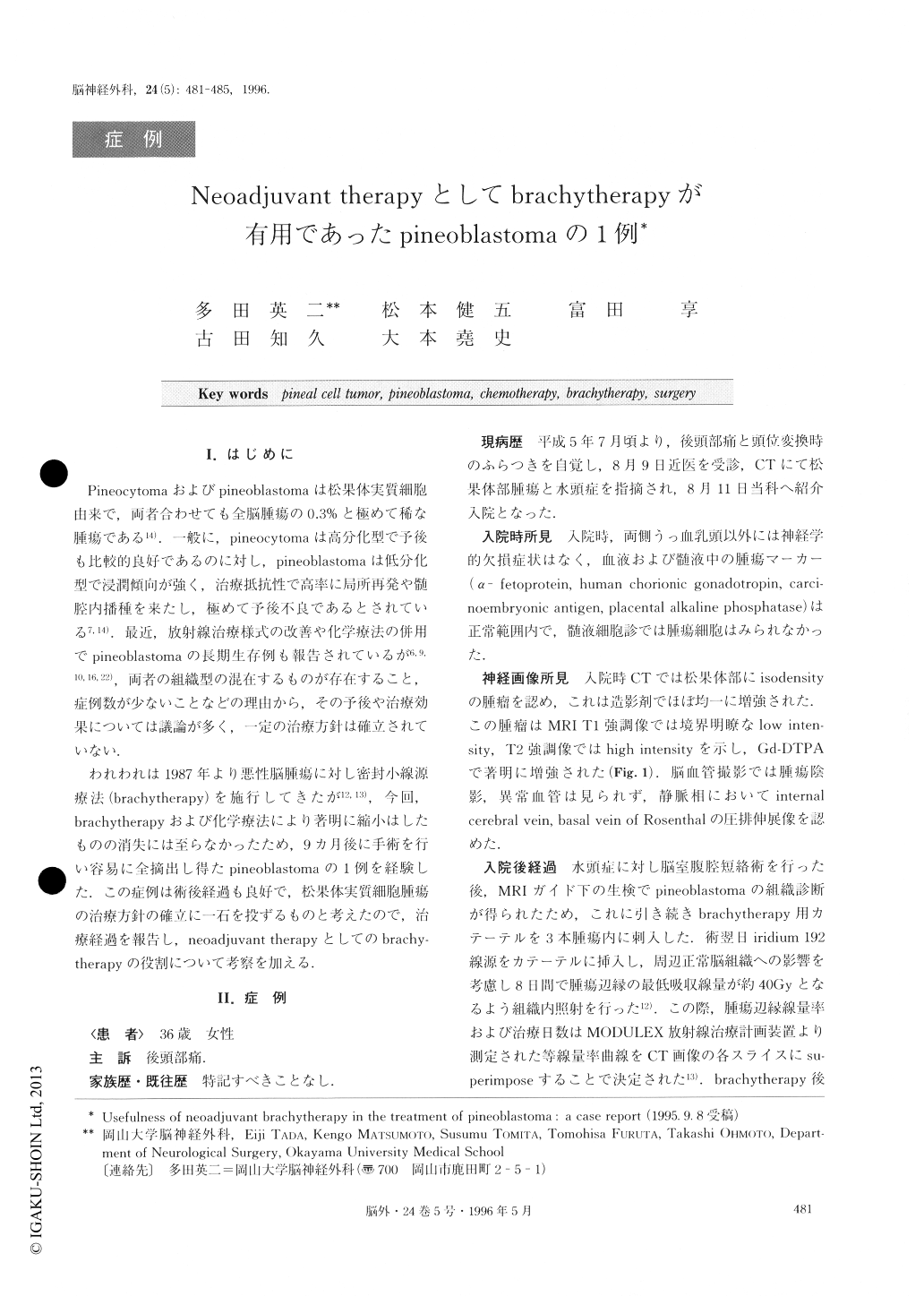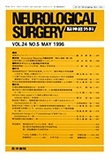Japanese
English
- 有料閲覧
- Abstract 文献概要
- 1ページ目 Look Inside
I.はじめに
Pineocytomaおよびpineoblastomaは松果体実質細胞由来で,両者合わせても全脳腫瘍の0.3%と極めて稀な腫瘍である14).一般に,pineocytomaは高分化型で予後も比較的良好であるのに対し,pineoblastomaは低分化型で浸潤傾向が強く,治療抵抗性で高率に局所再発や髄腔内播種を来たし,極めて予後不良であるとされている7,14).最近,放射線治療様式の改善や化学療法の併用でpineoblastomaの長期生存例も報告されているが6,9,10,16,22),両者の組織型の混在するものが存在すること,症例数が少ないことなどの理由から,その予後や治療効果については議論が多く,一定の治療方針は確立されていない.
われわれは1987年より悪性脳腫瘍に対し密封小線源療法(brachytherapy)を施行してきたが12,13),今回,brachytherapyおよび化学療法により著明に縮小はしたものの消失には至らなかったため,9カ月後に手術を行い容易に全摘出し得たpineoblastomaの1例を経験した.この症例は術後経過も良好で,松果体実質細胞腫瘍の治療方針の確立に一石を投ずるものと考えたので,治療経過を報告し,neoadjuvant therapyとしてのbrachy—therapyの役割について考察を加える.
The treatment strategy and prognosis of pineal cell tumors are still subjects of debate because of their rar-ity and the mixture of pineoblastoma and pineocytoma as components. Pineoblastoma is believed to be the more malignant tumor and total gross resection of this tumor is very difficult because of its invasive tendency and location. Although the effectiveness of external irradiation and chemotherapy has been reported, the outlook for patients with this tumor is extremely poor.
We treated a case of pineoblastoma with a single to-tal resection nine months after interstitial irradiation and chemotherapy. In this case, brachytherapy was success-ful as neoadjuvant therapy for decreasing the tumor's volume and clarifying its boundary.
The patient was a 36-year-old woman who had com-plained of occipital headache for about a month. On admission, neurological examination revealed bilateral papilloedema but, otherwise, there were no deficits. A magnetic resonance image (MRI) showed a homogene-ously enhanced tumor in the pineal region and obstruc-tive hydrocephalus. Two weeks after ventri-culo-peritoneal shunting, a stereotactic needle biopsy was performed using a BRW MRI-guided stereotactic apparatus, and three catheters for interstitial brachytherapy were implanted into the tumor through the biopsy tract. Iridium-192 seeds were inserted through the catheters and kept there for 8 days to irradiate 40 Gy at the tumor periphery. Four courses of chemotherapy with carboplatin (400mg/m2) and VP-16 (400mg/m2) were administered after brachytherapy. Repeat MRI scans every month showed a gradual re-gression of tumor volume. However, the tumor did not disappear and no further decrease in tumor volume was observed 8 months after brachytherapy. A suboccipital craniotomy was performed 9 months after brachyther-apy and en bloc tumor resection was achieved readily via an infratentorial supracerebellar approach. After re-ceiving another course of chemotherapy and external irradiation at 40 Gy, the patient was discharged with-out any symptoms and no residual tumor or recurrence was observed for 24 months after brachytherapy and 15 months after surgery.
The clinical course of this case suggests that a com-bination of stereotactic biopsy and brachytherapy with chemotherapy followed by surgery may be a good strategy for the treatment of pineal cell tumors regard-less of their histopathological features.

Copyright © 1996, Igaku-Shoin Ltd. All rights reserved.


